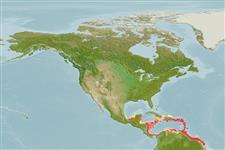Common names from other countries
>
Ophidiiformes (Cusk eels) >
Ophidiidae (Cusk-eels) > Ophidiinae
Etymology: Lepophidium: Latin, lepus, leporis = rabbit + Greek, ophis = serpent (Ref. 45335).
More on author: Robins.
Environment: milieu / climate zone / depth range / distribution range
นิเวศวิทยา
เกี่ยวกับทะเล,น้ำเค็ม สัตว์น้ำหน้าดิน; ระดับความลึก 27 - 165 m (Ref. 91765). Tropical; 21°N - 2°N, 97°W - 49°W (Ref. 91765)
Western Atlantic: along the northern coast of South America from Colombia to Cabo Orange, Brazil (north of the mouth of the Amazon); including Gulf of Campeche, Mexico, Nicaragua, Panama, shelf area from northern Puerto Rico to the US Virgin Islands.
ขนาด / น้ำหนัก / Age
Maturity: Lm ? range ? - ? cm
Max length : 27.0 cm SL เพศผู้/กระเทย; (Ref. 91765); common length : 18.0 cm TL เพศผู้/กระเทย; (Ref. 5217)
Short description
เครื่องมือที่ใช้ในการแยกชนิดสัตว์,สิ่งมีชีวิตออกจากกัน | สัณฐานวิทยา | ความยาวต่างๆ
เงี่ยงครีบหลัง (รวม) : 0; ก้านครีบอ่อนที่หาง (รวม) : 127 - 130; เงี่ยงครีบก้น: 0; ก้านครีบอ่อนที่ก้น: 104 - 112; สัตว์มีกระดูกสันหลัง: 69 - 72. This species is characterized by the following: usual number of vertebrae, precaudal 15 (14), caudal 56-57 (54-58), total 71-72 (69-72); fin rays, dorsal 127-130 (125-133), anal 106-108 (104-112) pectoral 20-21 (22); pyloric caeca usually 3 (1-4), most often with 2 in one tier and 1 in second, when 4, they are 3+1; first gill arch with rudimentary rakers 2 on the upper arm, 4 (rarely 5) developed rakers on the lower limb, usually 2 (1-3) rudimentary rakers anteriorly on the first arch; total rakers usually 8-9; dorsal-fin origin between neural spines 2-3 (18 specimens) or 3-4 (11 specimens), in most instances is almost directly over neural spine 3 (Ref. 91765).
Common species (Ref. 34024). Found on the continental shelf, on soft bottom (Ref. 5217). Oviparous, with oval pelagic eggs floating in a gelatinous mass (Ref. 205).
Life cycle and mating behavior
Maturities | การสืบพันธุ์ | Spawnings | Egg(s) | Fecundities | ตัวอ่อน
Robins, C.R., R.H. Robins and M.E. Brown, 2012. A revision of Lepophidium (Teleoastei, Ophidiidae), with descriptions of eight new species. Bulletin of the Florida Museum of Natural History 52(1):1-94. (Ref. 91765)
IUCN Red List Status (Ref. 130435)
CITES (Ref. 128078)
Not Evaluated
Threat to humans
Harmless
Human uses
เครื่องมือ
Special reports
Download XML
แหล่งที่มาจากอินเตอร์เน็ต
Estimates based on models
Preferred temperature (Ref.
115969): 21.7 - 27.1, mean 25.6 (based on 64 cells).
Phylogenetic diversity index (Ref.
82804): PD
50 = 0.5000 [Uniqueness, from 0.5 = low to 2.0 = high].
Bayesian length-weight: a=0.00234 (0.00101 - 0.00543), b=3.16 (2.98 - 3.34), in cm Total Length, based on LWR estimates for this Genus-body shape (Ref.
93245).
ระดับชั้นอาหาร (Ref.
69278): 3.6 ±0.7 se; based on size and trophs of closest relatives
ความสามารถในการกลับคืนสู่ปกติ (Ref.
120179): ความสูง, เวลาต่ำสุดที่จะทำให้ประชากรเพิ่มขึ้นเป็น 2 เท่าใช้เวลาน้อยกว่า 15 เดือน (Preliminary K or Fecundity.).
Fishing Vulnerability (Ref.
59153): Low vulnerability (23 of 100).
